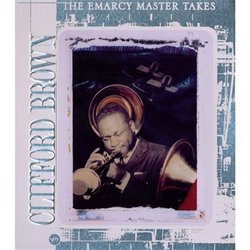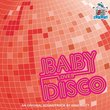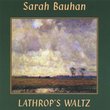| All Artists: Clifford Brown Title: Emarcy Master Takes (W/Book) (Spkg) Members Wishing: 2 Total Copies: 0 Label: Hip-O Select Original Release Date: 1/1/2010 Re-Release Date: 2/23/2010 Album Type: Box set, Limited Edition Genres: Jazz, Pop Style: Number of Discs: 4 SwapaCD Credits: 4 UPC: 602527043982 |
Search - Clifford Brown :: Emarcy Master Takes (W/Book) (Spkg)
 | Clifford Brown Emarcy Master Takes (W/Book) (Spkg) Genres: Jazz, Pop Clifford Brown: The Emarcy Master Takes includes the 49 master takes the Brown-Roach Quintet recorded for the EmArcy label, an 18-month collaboration that resulted in some of the most enduring jazz of all time. This Verve ... more » |
Larger Image |
CD DetailsSynopsis
Album Description Clifford Brown: The Emarcy Master Takes includes the 49 master takes the Brown-Roach Quintet recorded for the EmArcy label, an 18-month collaboration that resulted in some of the most enduring jazz of all time. This Verve Select limited edition 4-CD set contains, in chronological order of recording, all of the tracks that made up the classic albums Clifford Brown and Max Roach, Clifford Brown With Strings, Brown and Roach Incorporated, Study In Brown, Best Coast Jazz, and At Basin Street, as well as tracks featured on several posthumous releases, from Caravan to More Study In Brown and others. Playing with Brown and Roach are regular members of their quintet-Harold Land (tenor saxophone), Richie Powell (piano), George Morrow (bass) and Sonny Rollins, who replaced Land-plus a slew of other star players, as well as a Los Angeles string section beautifully arranged and conducted by Neal Hefti. EmArcy's Bob Shad produced the sessions. (Further sessions with vocalists Dinah Washington, Sarah Vaughan and Helen Merrill will be presented on a second multi-disc volume of master takes.) Similar CDs
|
CD ReviewsProgramming code included with CDs, so you can listen to eac German Artist | California | 04/28/2010 (5 out of 5 stars) "This is a review of the 4 CD collection, not the MP3 download.
Clifford's wonderful music is peerless, fresh, free, inventive, melodic, sometimes bouncy, always tender and warm and life-affirming. It is beautifully represented on these CDs, which collect all the master takes of the (instrumental) music Clifford recorded for EmArcy, in chonological sequence. At a later date, Hip-O-Select, part of Verve, will release his three albums with Dinah Washington, Helen Merrill and Sarah Vaughan. The newly remastered music sounds great,, remastered by Kevin Reeves, who did the 2000 remastering for the "Sarah Vaughan" CD, at the same facility. The sound for the Sarah Vaughan album is improved over the previous 1990 release. I don't have the original instumental CDs to compare to this collection. The four CDs are housed in an old fashioned 4 page quality album made from extremely thick and sturdy cardboard (not sure whether it may scratch the CDs, but the surface of the cardboard is very slick and smooth. The outer tin box has an aggressive, acidic design which doesn't suit the music, and only fits in the CD shelf lying flat. The album itself, spine up, and the booklet, have the exact dimensions of a jewel case and fit in the shelf. The booklet is over-designed, making the text in the otherwise excellent presentation hard to read. However, the info contained in the booklet is wonderful. Newly written portraits of Clifford, and of each of his albums. The next section has, album by album all the info when and where the recordings took place, with which musicians, and more. Many really wonderful photos, which are flattered by the silver covered paper. Best of all, at the end of the booklet is a short section with each of the album titles, the song titles and LP break (//), and a single line "programing code" to help you play each originally released album by itself. All you have to do is put all four CDs in your player (if you have a multi disk player, that is) and put in the code, for example: Clifford Brown and Max Roach, EmArcy MG 36036 [12 inch LP} Delilah / Parisian Thoroughfare /The Blues Walk // Daahoud / Joy Spring / Jordu / What Am I Here For Disc 1 tracks 1&3, Disc 3 track 19, Disc 1 tracks 13-10-4, Disc 4 track 1 This is the first time I saw a publisher give us such a simple programming code. Usually I have to spend a lot of time writing down the code, after a lot of cross referencing and research as to the correct running order of the original LPS. Usually we only get the info on the different recording sessions, and mention for which albums they were used. But it's all covoluted if you want to program the original albums, in addition of not knowing the original running order of the LPs. Here, thanks to a thoughful gesture of the producers, it's really quick and easy. In addition, the four CDs play really well in their entirety, sincere it's the chronological order of performance (which the LP albums hardly ever follow) and there's no repetitive alternate tracks. The beautiful cardboard album has, on the cover, without words, a painting by Stanley Rayfield that is really lovely. It's a montage of 4 images of Clifford playing the trumpet, in different poses, and the painting is part child-like naif, and part expertly rendered, and the whole composition has a wonderful feeling of innocence and illustrates beautifully the unique character of this gentle, warm, lovable, intelligent man Clifford. Actually, when I opened the box and saw the image on the cover of this album, I was moved to tears. On the bottom of the tin box is another nice illustration by Danielle Skorzanka, a close up of Clifford playing the trumpet. This image, and even more so, the photos in the booklet reveal the degree of utmost concentration and dedication and power with which Clifford Brown played the trumpet. It's almost as if every feature of his face not necessary to play the trumpet has folded in, his eyes are pinched close, his nose nestles between his cheeks and upper lip. Everything is streamlined, and the only protruding part of the anatomy of his face is the trumpet, which has become his most important body part. As you can see, I cherish this set. Clifford's music on these CDs is peerless and speaks for itself; the lovingly created physical presentation (save the tin box cover) of this collection mirrors the character of the man, who showed his great fellow Jazz musicians that it was possible to play great music without being high on heroin. Update 5 May 2010: Since my original review, I was able to compare the sound quality of the 1998 single release of "Clifford Brown With Strings" with the identical 12 songs contained in this collection. The sound quality of the two realeases is DIFFERENT. I prefer the single CD release. These 12 songs were recorded in January 1955, in Mono. The trumpet playing in the "Clifford Brown With Strings" release is very clear and distinct, and you can make out every subtlety. Being Mono, the sound is centered between the speakers, and the sound of the trumpet is natural, and round, and clearly in front of the string music. The Mono recording of these same songs in the more recent remastering (by the same engineer) in this collection seem to have been processed in pseudo (fake) Stereo, for the sound field is still Mono, but much wider, almost from left to right speaker. That benefits the the sound of the violins, which sound fuller. But unfortunately the trumpet doesn't sound as direct and natural anymore, but recessed into the violins. Moreover, in some places there is a strange effect of the sound shifting, flickering from left to right to left to right. Maybe that's a consequence of the fake stereo effect. This does not happen in the single release. As a whole, the sound of these 12 songs in this collection is a very enjoyable, more spacious experience, but more in a lush "lounge music" sort of way. The sound of the trumpet is cloaked in the strings. This dilutes the emotional impact of Clifford Browns sensitive playing, most notably in the famous "Stardust", which is less moving in the newer remastering. If your interest is primarily in enjoying all the subtleties of Clifford Brown's playing, the more natural, clearer, more direct sound of the trumpet in the single CD release of "Clifford Brown With Strings" would be more suitable. I like it better. I don't have the older single releases to compare to the new remastering of the rest of the collection, which may very well be improved upon older editions. I'm still very glad I bought this collection and highly recommend it." |



